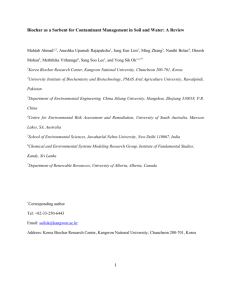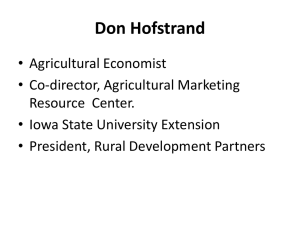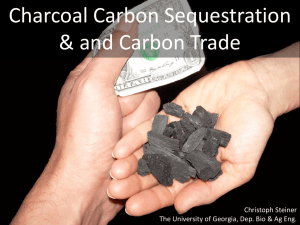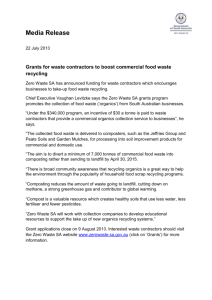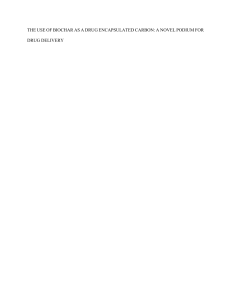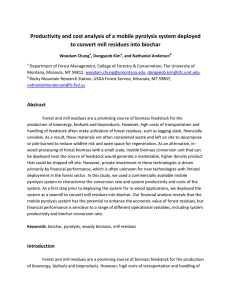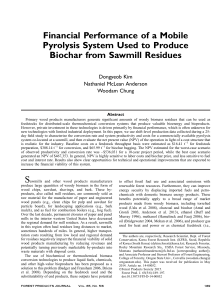Urban waste management
advertisement
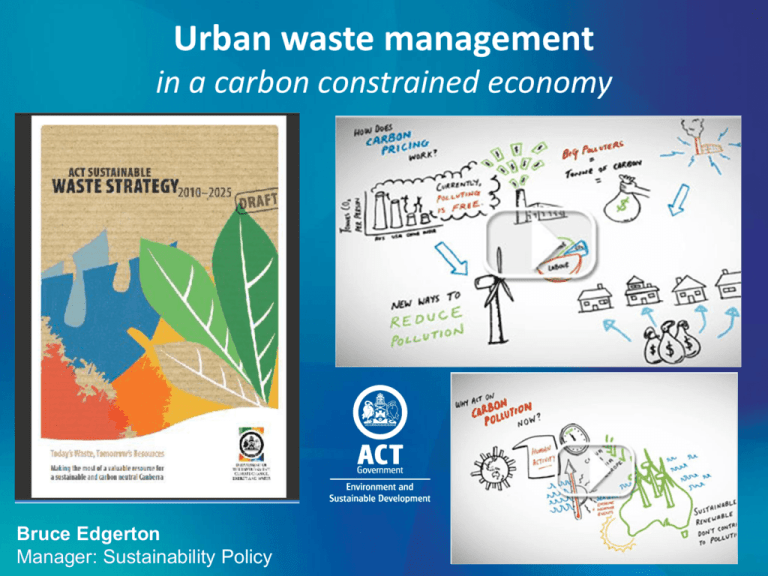
Urban waste management in a carbon constrained economy Bruce Edgerton Manager: Sustainability Policy Key Messages • Implications of a carbon constrained economy for urban waste management: 1. get organics out of landfill; 2. recycle-recover materials to highest-value use were possible; 3. generate energy from appropriately sorted residual material; 4. explore the next generation of energy-from-waste technologies to: o Generate renewable energy or transport fuels and/or sequester carbon. • Draft Waste Strategy & consultancies (www.environment.act.gov.au) – Provide a good starting point for discussion – Public consultation on web – Biochar trial & further analysis of options underway • Final ACT waste strategy to be released this year Context ACT • 1996 No Waste by 2010 released – Resource recovery: 43% in 1996 75% in 2005 71% in 2010 • Climate Change & Greenhouse Gas Reduction Act (October) 2010 Federal • Carbon Pricing Mechanism • Carbon Farming Initiative (CFI) – Legacy landfill emissions – Biochar – Soil carbon (via compost?) Outcomes 1. 2. 3. 4. Less Waste Generated Full Resource Recovery A Clean Environment A Carbon Neutral Waste Sector Systems approach to waste management Potential new waste services, infrastructure & markets PEF = process engineered fuel a.k.a RDF Three pronged approach Programs Outcomes 1. Commercial waste scheme • Resource Recovery > 80% by 2015 2. Organics recovery >85% by 2020 3. Energy from waste – – – Staged implementation appropriately sorted residuals i.e. no mass burn incineration >90% by 2025 No recoverable material sent to landfill ie approximately 5-10% deemed unrecoverable • Carbon neutral waste sector by 2020 – Implies offsets The Role of Energy from Waste • Adding value to under-utilised or landfilled waste streams – Thermal Coal Substitute = $50-150/tonne • Creating valuable products from organic wastes o renewable electricity o biochar and/or liquid fuels Conclusion • • • • ACT Government takes its climate change responsibilities seriously The draft ACT waste strategy is framed in this context The final waste strategy is to be released this year Waste management could contribute to climate change mitigation via: – avoided emissions from landfill o 2.5% of total GHG emissions – Avoided emissions via recycling o As important as landfill GHG emissions – but o doesn’t impact on the ACT’s GHG inventory – generating renewable energy – sequestering carbon &/or generating renewable transport fuels Extra Slides draft waste strategy consultation • Released 8 Dec 2010 to 28 Feb 2011 – draft ACT Sustainable Waste Strategy 2010-2025 – URS- EcoWaste & Inovact consultancy reports • Held – 6 community forums – 1 waste-industry forum – 3 presentations at waste conferences 2010-11 • Results – All submissions made public (www.environment.act.gov.au/waste) – Generally quite positive feedback o o o 20,000 participants & 34,000 submissions • Third bin was 45 out of 1000 issues – ACT has high service provision expectations... and Queanbeyan already has a garden-waste bin! Including for energy-from-waste... providing it was staged and/or “right sized” not incinerated – Want more services o “Time to talk- Canberra 2030” E-waste recycling Bulky waste collection Garden waste collection 1. 2. 3. 4. 5. C&D largest material stream Garden waste Commercial waste Household waste Urban forest & biosolids underutilised Energy-from-waste: technology options • Landfill gas • In-vessel anaerobic digestion • Direct combustion • Process Engineered Fuels (PEF) - for export outside the ACT • Advance thermal options • Gasification • Slow pyrolysis • Flash pyrolysis • Plasma et al. Appropriate feedstocks for EfW Dry – tonnes/yr of dry matter Wet - tpa dry (tpa wet) • C&D timber • Biosolids (sewage sludge) – 15-30,000 • Urban forest material – 10,000 and growing • Dry commercial waste (PEF) – 10-25,000 • Garden waste – 180-240,000 – 13-15,000 (30-45,000) • Sorted commercial organics – 8-16,000 (20-35,000) • Sorted domestic organics – 10-20,000 (30-40,000) Green – available now (3-10MW) Orange – potentially available by 2015 Red – post 2015 or not available Biochar Trial manufactured by AnthroTerra using low temperature (≈450oC) pyrolysis Results • Sequestration Biochars 1. – 2. – C&D timber + dry green waste ≈ 19 MJ/dry tonne – Biosolids & household organics = 12.5 - 13.8 MJ/dry tonne • Agronomic quality??? – Looks good – High Zn, Pb, Cu, Cr in MSW 3. 4. torrefied with biosolids at 250oC after pyrolysis C&D timber + biosolids household organics (from MSW) – 5. micro & macronutrients added after pyrolysis C&D timber – – 33-54% kg biochar/kg dry input – 71-92% stable carbon • Energy yield C&D timber from SITA’s Kemp’s Creek residualwaste MRF (SAWT) processing Liverpool’s residual waste bin Urban forest material (green waste) + biosolids Biochar Pot Trials ANU Fenner School of Environment & Society • >1600 pots • 0.5-6% biochar blended with – compost made from garden waste in the ACT – a local top soil • 5 species – – – – – Breccia Pansy Acacia Annual grass Perennial grass
